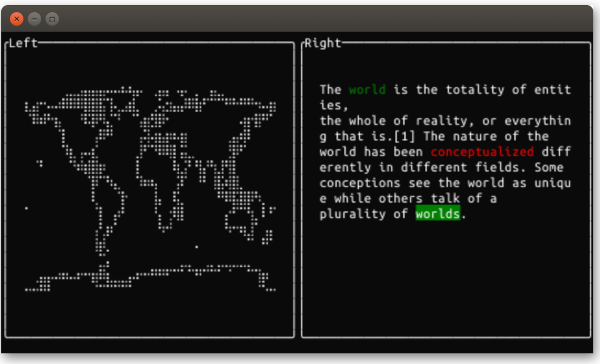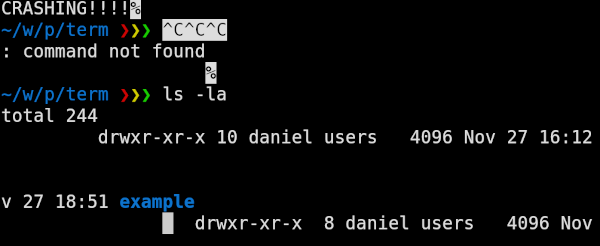PHP Term
Last modified 2023/11/27 20:04TL;DR Term is a low-level terminal manipulation library for PHP based on
Crossterm. Give it a star.
 (professional) Term logo
(professional) Term logo
When I started porting Ratatui to PHP (see previous post) I didn’t fully realise what I was getting myself into.
PHP-TUI is a framework which allows you to create terminal user interfaces, but it does not in itself provide the mechanism to interact with the terminal.
Symfony Terminal ¶
My first idea was to use the Symfony console as a “backend” for PHP-TUI as (not) detailed in my previous post. But this soon ran into difficulties:
- No provision for reading events from the console.
- Involved interpolating lots of markup into the strings.
What are Events? ¶
What are events anyway? How can we read input from the user?
When you type something in the terminal it can be read by STDIN:
<?php
$foo = fgets(STDIN);
echo $foo;
While this method is fine for reading a line of input from the user, it’s not so great if you want to know if the user:
- Pressed tab
- Moved the mouse
- Pressed delete
Additionally we want to know things like did the user resize the terminal and where is the cursor anyway?
Symfony doesn’t need these features, but if you want to build a text editor, interactive debugger, or a presentation framework they would sure be useful…
Porting another Rust library ¶
Ratatui supports a number of backends which fulfil the requirements set out above:
Ratatui uses Crossterm by default, so I decided to 🦀 port it to PHP 🐘.
ANSI Painting ¶
The first task was to bring the Term library to parity with the Symfony
backend, and that meant I needed a way to write ANSI codes to the terminal.
Crossterm uses an (optional) queue system, which enables you to queue output
commands into a buffer, which is either flushed implicitly when it’s full or
when you explicitly call flush.
For the following Crossterm example prints some text to STDOUT with a blue foreground and
a red background and then resets the colors back to normal.
let w = stdout();
queue!(
w,
SetForegroundColor(Color::Blue),
SetBackgroundColor(Color::Red),
MoveTo(10, 10), // move cursor to line 10 col 10
Print("Styled text here."),
ResetColor
)?;
w.flush()?;
Wait! That’s pretty verbose!
To do the same in the Symfony console you’d do
<fg=blue;bg=red>Styled text here.</> but this is a low-level library,
typically the user will never use this API! (incidentally PHP-TUI supports a
subset of the Symfony markup!).
Term takes a more
OOP approach:
<?php
$terminal = Teminal::new();
$terminal->queue(
Actions::setForegroundColor(Colors::Blue),
Actions::setBackgroundColor(Colors::Red),
Actions::moveCursor(10, 10),
Actions::printString('Styled text here'),
Actions::reset()
);
$terminal->flush();
Painter Backends ¶
One of the advantages of the “OOP” approach is that behind the scenes there is
a “backend”. The default backend is the AnsiPainter but there is also a
StringPainter:
<?php
$painter = new StringPainter();
$terminal = Terminal::new($painter);
$terminal->queue(
Actions::setForegroundColor(Colors::Blue),
Actions::printString('Styled text here'),
);
$terminal->flush();
echo $painter->toString(); // plain text output with no escape codes
and there is also a (very experimental) HTML canvas painter, used for the documentation, which can write directly to HTML:
 generated using the HTML canvas painter
generated using the HTML canvas painter
It wouldn’t be that hard to write a backend that creates images or even animated GIFs…
Anyway, Term is now, possibly, at parity with Crossterm in terms of writing
escape sequences.
Raw Mode ¶
Have you ever exited an application and the terminal is fucked up?

That’s raw mode! By default your terminal assumes various default behaviors, like
returning the cursor to the start of the line when there is a newline, or
interpreting ctrl-c as SIGINT.
These behaviors get in the way when writing a fully interactive terminal application, so they need to be disabled.
Rust is able to make calls to the
termios C library,
PHP can’t do that, instead Term will basically call out to stty which is
available on Linux and (I hope) Mac:
stty raw
Try it! You can break your terminal right now!
Term presents the API as:
<?php
$terminal = Terminal::new();
$terminal->enableRawMode();
$terminal->disableRawMode();
Events ¶
So after porting the “write ANSI codes” code, I could move on to the main concern: reading events.
For this I essentially progressively ported the Crossterm event parser. I think it’s largely at parity now, although it’s surely missing a few things.
Usage looks something like this:
<?php
$terminal = Terminal::new();
$terminal->enableRawMode();
$terminal->execute(Actions::enableMouseCapture());
while (true) {
while ($event = $terminal->events()->next()) {
// print a string representation of the event to the terminal for fun
$terminal->execute(Actions::printString($event->__toString()));
$terminal->execute(Actions::moveCursorNextLine());
if ($event instanceof TerminalResized) {
// the terminal was resized
}
if ($event instanceof MouseEvent) {
// the mouse did something
}
if ($event instanceof CodedKeyEvent) {
if ($event->code === KeyCode::Esc) {
break 2;
}
}
if ($event instanceof CharKeyEvent) {
// ctrl-c
if ($event->char === 'c' && $event->modifiers === KeyModifiers::CONTROL) {
break 2;
}
}
}
usleep(10000);
}
$terminal->disableRawMode();
There is a runnable events example here.
Isopmorphic Transformations! ¶
While working on testing PHP-TUI I wanted to be able to run and generate snapshots of the examples. The examples are standalone scripts like:
<?php
// ...
require 'vendor/autoload.php';
$display = DisplayBuilder::default()->build();
$display->draw(
CanvasWidget::fromIntBounds(-180, 180, -90, 90)
->marker(Marker::Braille)
->draw(
MapShape::default()
->resolution(MapResolution::High)
->color(AnsiColor::Green)
)
);
I could just run this process and dump the output to a file - ANSI codes and all:
[2;34H[32m⣀⣠⣤⣠⢤⢖⠐⠐[2;43H⠒⡐⡴⢔⡄⠄⠄⠤⠠⠠⠄⠔[2;56H⠒⠐[2;59H⠄⠠⠦⢠⠴[2;65H⡠⢠[2;78H⢀⢀⣀⢀[2...
But that sucks!
I wrote a parser which can convert
ALL the escape sequences supported by Term back to the original actions, which
can then be replayed!
<?php
$actions = AnsiParser::parseString($rawOutputOfExampleScript);
$terminal = Terminal::new();
$terminal->execute(...$actions);
In the example above we’d just be converting the raw output to actions (an
isomorphic mapping, I think) and
then converting them back to the same raw output. But if we change the backend
to the StringPainter we can strip all the styling information, while
preserving the cursor movement:
⢀⣀⣀⣀⡠⡠⢄⣀⡀⣀⣀⣀⠤⠄⢄⢠⣀⡀⣀⡀ ⢀ ⣀
⢀⡴⣶⣶⣷⣝⣿⣿⣿⣿⣯⣞⡛⠻⠧⠤⣄ ⣰⡟⠁ ⠙⠛⠛⠋ ⠈⠉⣁⡤⠔⢶⣀⣀⣀⣠⠬⠭⠝⠓⠳⣦⣀⣀⣀⣀⠠⣤⡠⢤⠄
⢿⣤⣴⣾⡍⠉⠉⠉⠉⠒⠉⠙⠋⠛⠛⠚⠚⠛⠛⣙⣿⣽⣹⣟⣹⡦⠄⠹⡏ ⣠⠤⠔⠘⣯⣤⡤ ⢀⡄⢊⣭⡍⠉⣶⣴⠶⠆⠙⠓⠋⠛⠾⠏⠈ ⠉⠉⠉ ⠈⠈⠉⠋⠊⠃⢉⡻
⠘⣓⣶⠶⠟⠛⠒⠒⣦⡀ ⠘⠧⢄⣁⡻⠉⠛⠓⣄⡀⠈⠙⠃ ⢀⣴⣆⠘⣷⣦⣞⡽⠞⠂ ⢀⣄⡒⠐⠒⡭⣻⠃⠋⠉⠁
⠉⠛⡶ ⠈⠃ ⢴⣶⣶⢿⡄ ⠈⠻⡟⠋⠉⣀⡀ ⣀⣀⡄ ⣀⣄ ⢀⡼⡧ ⠋⠁
⢧ ⢠⡖⠋⠉ ⢸⣉⣱⣋⣹⣿⡿⢶⣾⣓⣓⠛ ⢻⣷ ⠠⣶⢦⡎⣉⣼⠏
⠙⣶⣀ ⡠⠤⠤⣴⣋ ⢀⡼⠁⠁ ⠈⠑⠲⠞⠛⠺⣏ ⢤⣀⡀ ⣱⠈⠛⠋⠉
⠲⡤ ⠈⠛⢦⡀⣇⣠⡴⠚⣿⣤⣄⡀ ⠠⡇ ⠹⣧⡀⠈⢉⣿⠉⠙⢦ ⡠⠒⣆ ⣴⡔⠚⣛
⠈⠉⠓⢫⣇⣀⣤⡤⣤⣄ ⠘⢧ ⠙⠷⢶⠍ ⠈⢦⣏ ⠈⣷⢦⡽ ⢀⣿⣦
⢈⡽ ⠈⠙⢢⡀ ⠈⠑⠒⠚⠙⢲ ⡠⠎ ⠈⠉ ⠐⢿⢷⢠⠴⢻⣎⣯⣄⡀
⠸⡅ ⠉⠉⢒⠄ ⠈⢦ ⣞ ⠻⠯⣿⣏⣛⣘⠛⠿⣏⡱⣴⠷⢤⡀
⠄ ⠘⢤⡀ ⡏ ⣞ ⢀⡼⣠⢾ ⢡⡗⠞⠹⢤⠷⡈⠁ ⠉⠰ ⢀⡤
⡇ ⡔⠚ ⠘⡄ ⢠⡽ ⠯⠇ ⢰⠋⠁ ⠙⢦ ⠈⠓
⣸ ⠠⡤⠞ ⠹⠤⠴⠊ ⠧⠤⠖⠒⠦⣆ ⢀⠞ ⠠⣄⡀
⣾⢀⡾⠋ ⠈⠹⠟ ⢠⣴⠟⠁
⢧⣾⡁⠴ ⠘⠃
⢀⣀⡀
⢀⣀⣀⢀ ⢀⣄⣀⣀⣀⣀⣀⣤⣾⠻⡅ ⣀⡤⠤⠤⠤⠤⠤⠤⠤⠤⠴⠒⠴⠒⠊⠉⠙⠒⢲⡦⠴⠒⠋⠙⠙⠚⠉⠉⠉⠉⠋⠉⠉⠉⠉⠙⠒⠒⠲⠤⢤⣤
⠰⠶⣶⣶⠏⠉⠉⠉⠉⠉⠉⠉⠉⠉⠉ ⠰⠶⣋⣭⣥⣠⣴⣶⣆⣰⡶⠖⠉⠉⠁ ⣼⣿
⠉⠉⠉⠉⠈⠉⠙⠉⠁ ⠈ ⠉⠉⠉
The above is actually the snapshot for the map example script.
Conclusion ¶
I’ve been developing Term in parallel with PHP-TUI for the past months, and
today I decided to finally split it out to it’s own
package and add some of the missing
features.
It’s still rough around the edges and deserving of it’s 0.1.0 tag. The API
may change yet but it provides a pretty comprehensive API for interacting with
the terminal as you can see from the
README documentation.